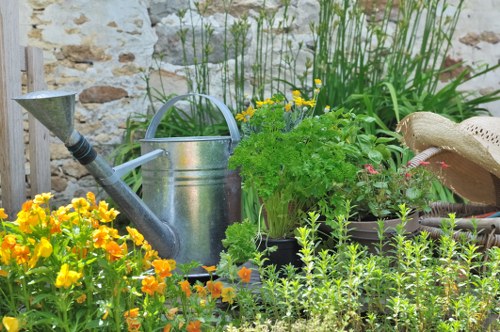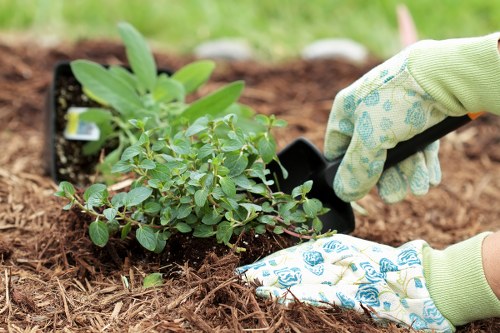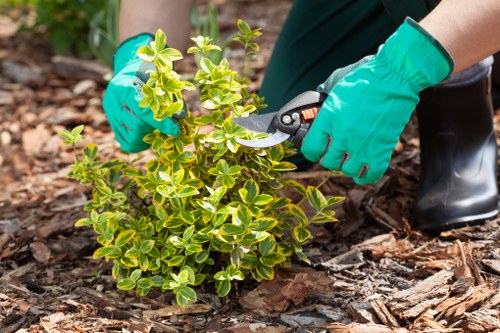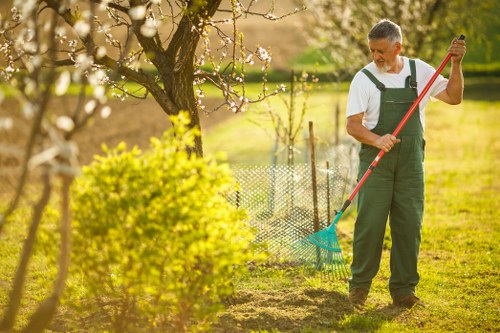Hedge Trimming in Sudbury: Enhancing Your Landscape with Professional Care
Introduction to Hedge Trimming

Maintaining a beautiful and healthy landscape is essential for homeowners in Sudbury. One of the key aspects of landscaping is hedge trimming, which not only enhances the aesthetic appeal of your property but also promotes the health of your hedges. Proper hedge trimming can make a significant difference in the overall appearance and longevity of your greenery.
Hedge trimming involves cutting and shaping hedges to maintain their form and encourage healthy growth. It is a task that requires skill and knowledge to ensure that the plants are not harmed during the process. Whether you have ornamental hedges or functional ones that serve as privacy screens, regular trimming is crucial.
In Sudbury, where the climate can be harsh, selecting the right time and method for hedge trimming is vital. Understanding the local weather patterns and plant varieties will help you achieve the best results. This article delves into the essentials of hedge trimming in Sudbury, offering tips, techniques, and insights for maintaining your hedges effectively.
Benefits of Regular Hedge Trimming

Regular hedge trimming offers numerous benefits that go beyond mere aesthetics. Here are some key advantages:
- Enhanced Appearance: Well-trimmed hedges add structure and beauty to your garden, making your property more inviting.
- Healthier Plants: Trimming removes dead or diseased branches, allowing the plant to focus its energy on new growth.
- Improved Airflow: Thinning out dense foliage improves air circulation, reducing the risk of fungal diseases.
- Increased Privacy: Maintaining the right height and density of hedges ensures they serve their purpose as natural privacy screens.
- Safety: Overgrown hedges can obstruct pathways and pose safety hazards. Regular trimming keeps them in check.
By investing time and effort into regular hedge trimming, you can enjoy a lush, healthy, and visually appealing landscape that stands the test of time.
Moreover, well-maintained hedges can increase the value of your property, making it more attractive to potential buyers should you decide to sell in the future.
When to Trim Hedges in Sudbury

Timing is crucial when it comes to hedge trimming. In Sudbury, it's essential to consider the local climate and seasonal changes to determine the best times for trimming.
Generally, the ideal times for hedge trimming are:
- Late Spring: After the initial growth period, trimming in late spring encourages bushier growth and shapes the hedge for the upcoming seasons.
- Late Summer: A second trim in late summer helps maintain the shape and removes any overgrown branches that may have developed during the summer months.
Avoid trimming hedges during extreme weather conditions, such as late fall or early winter, as this can stress the plants and make them more susceptible to damage from frost and freezing temperatures.
Additionally, specific hedge types may have unique trimming requirements. It’s important to research or consult with a professional to determine the best trimming schedule for your particular hedges.
Techniques for Effective Hedge Trimming

Proper hedge trimming techniques ensure that your hedges remain healthy and aesthetically pleasing. Here are some essential techniques to consider:
1. Tools and Equipment
Using the right tools is fundamental for effective hedge trimming. Common tools include:
- Pruning Shears: Ideal for small hedges and precise cuts.
- Hedge Trimmers: Suitable for larger hedges and faster trimming.
- Loppers: Used for thicker branches that pruners cannot handle.
- Safety Gear: Gloves, safety glasses, and protective clothing to ensure personal safety during trimming.
Regular maintenance of your tools ensures clean cuts and reduces the risk of disease transmission between plants.
2. Trimming Techniques
When trimming, aim for a uniform shape that complements your landscape. Here are some techniques to achieve this:
- Top and Sides: Trim the top slightly narrower than the base to allow light to reach all parts of the hedge.
- Shearing: Use shearing techniques for a manicured and precise appearance.
- Selective Pruning: Remove specific branches to encourage healthy growth and eliminate any that are dead or diseased.
It’s important to maintain the natural form of the hedge while ensuring it remains tidy and well-shaped.
Additionally, avoid trimming too aggressively, as this can lead to excessive stress on the plants and hinder their growth.
Choosing the Right Hedge Plants for Sudbury

Selecting the appropriate hedge plants is fundamental to creating a successful and sustainable landscape in Sudbury. Consider the following factors when choosing hedge varieties:
Climate Compatibility
Choose plants that are well-suited to Sudbury’s climate, which includes cold winters and warm summers. Hardy species that can withstand temperature fluctuations are ideal.
Growth Habit
Different hedge plants have varying growth habits. Some are dense and compact, while others may be more open and airy. Consider the desired look and functionality when selecting plants.
Maintenance Requirements
Some hedges require more frequent trimming and care than others. Choose plants that align with your available time and willingness to maintain them.
Popular hedge plants for Sudbury include:
- Boxwood: Known for its dense foliage and ability to be shaped into precise forms.
- Privet: Fast-growing and versatile, suitable for creating privacy screens.
- Yew: Long-lived and tolerant of heavy pruning, making it ideal for formal hedges.
- Arborvitae: Evergreen with a tall, columnar shape, perfect for privacy and windbreaks.
By selecting the right hedge plants, you can ensure a beautiful and sustainable landscape that thrives in Sudbury’s unique environment.
Additionally, incorporating a mix of evergreen and deciduous hedges can add visual interest throughout the year.
Common Hedge Trimming Mistakes to Avoid

Avoiding common mistakes in hedge trimming can save your plants from damage and ensure they remain healthy. Here are some pitfalls to watch out for:
- Over-Trimming: Cutting too much foliage can stress the plant and reduce its ability to photosynthesize.
- Improper Timing: Trimming at the wrong time of year can interfere with the plant’s natural growth cycle.
- Using Dull Tools: Dull blades can cause ragged cuts, making plants more susceptible to disease.
- Ignoring Plant Health: Trimming diseased or infested branches without addressing the underlying issues can worsen plant health.
Steering clear of these mistakes ensures that your hedges remain robust and attractive.
Additionally, learning the specific needs of your hedge varieties can help you tailor your trimming practices for optimal results.
Hiring Professional Hedge Trimming Services in Sudbury

While DIY hedge trimming can be manageable for smaller properties, hiring professionals offers numerous advantages:
- Expertise: Professional trimmers have the knowledge and skills to handle different hedge types effectively.
- Proper Equipment: They use the right tools and techniques to ensure clean and precise cuts.
- Time-Saving: Professionals can complete the job more efficiently, allowing you to focus on other tasks.
- Healthier Hedges: Expertise in plant care ensures that your hedges remain healthy and vibrant.
When choosing a professional service, consider the following:
Experience and Reputation
Look for companies with a proven track record and positive reviews from clients in Sudbury.
Services Offered
Ensure that the service provider offers comprehensive hedge trimming, including pruning, shaping, and maintenance.
Pricing
Compare quotes from different providers to find a service that fits your budget without compromising on quality.
Investing in professional hedge trimming services can lead to a more polished and long-lasting landscape.
Contact us today to schedule your hedge trimming service and transform your Sudbury landscape!
DIY Hedge Trimming Tips and Best Practices

If you prefer to take on hedge trimming yourself, here are some tips to help you achieve professional-looking results:
1. Plan Your Trim
Decide on the shape and height of your hedges before you begin. Using stakes and strings can help guide your trimming lines for uniformity.
2. Start with Clean Cuts
Use sharp, clean tools to make precise cuts. This reduces the risk of damaging the plant and prevents disease entry points.
3. Trim in Stages
For larger hedges, trim in sections to ensure evenness and to manage the workload effectively.
Remember to take breaks and assess your progress regularly to maintain consistency.
4. Maintain Consistency
Aim for symmetrical trimming to enhance the overall appearance of your hedges. Regular maintenance trims will make the process easier and less time-consuming.
Additionally, keep an eye out for any signs of stress or disease in your hedges and address them promptly.
Tools Needed for Hedge Trimming

Having the right tools is essential for effective hedge trimming. Here’s a list of necessary equipment:
- Hedge Trimmer: Electric or gas-powered, depending on the size of your hedges.
- Pruning Shears: For detailed and precise cuts.
- Loppers: To handle thicker branches that are beyond the capacity of shears.
- Gloves: Protect your hands from thorns and debris.
- Safety Glasses: Guard your eyes against flying particles.
- Stakes and Strings: For guiding straight and even trims.
Regularly inspect and maintain your tools to ensure they are in good working condition. Clean them after each use to prevent rust and wear.
Investing in high-quality tools can make the trimming process more efficient and produce better results.
Seasonal Considerations for Hedge Trimming

Different seasons require different hedge trimming approaches to maximize plant health and growth.
Spring Trimming
In spring, focus on removing any winter damage and shaping the hedge for the new growth period. This is the time to encourage bushier and healthier plants.
Summer Trimming
Summer trimming helps manage excessive growth and maintains the desired shape. It’s also an opportunity to remove any flowers or seeds that may divert energy from the plant.
Autumn and Winter
Avoid heavy trimming during these seasons as plants are preparing for dormancy. Light pruning can be done if necessary, but it’s best to reserve major trimming for the warmer months.
Understanding the seasonal needs of your hedges ensures that they remain resilient and vibrant throughout the year.
Book your service now to take advantage of seasonal hedge trimming and keep your garden in top shape!
Understanding Different Hedge Types
[IMG_11]Different hedge types require specific trimming techniques and care routines. Here are some common hedge varieties found in Sudbury:
Evergreen Hedges
Evergreen hedges, such as boxwood and arborvitae, retain their foliage year-round, providing consistent privacy and structure to your landscape. They require regular trimming to maintain their shape and density.
Deciduous Hedges
Deciduous hedges, like privet and lilac, shed their leaves in the fall and regrow in the spring. They often require more pruning after flowering to encourage new growth and maintain their form.
Flowering Hedges
Flowering hedges, such as forsythia and hydrangea, not only offer beauty through their blooms but also attract pollinators. Pruning should be timed to avoid cutting off flowering buds.
Each hedge type has unique characteristics and care requirements. Familiarizing yourself with these can help you provide the best possible maintenance for your plants.
Additionally, mixing different hedge types can create a diverse and dynamic landscape that enhances the overall beauty of your property.
Eco-Friendly Hedge Trimming Practices
[IMG_12]Adopting eco-friendly practices in hedge trimming can benefit both your garden and the environment. Here are some sustainable approaches:
- Use Manual Tools: Whenever possible, opt for manual hedge trimmers instead of gas-powered ones to reduce carbon emissions.
- Recycle Green Waste: Compost the trimmed branches and leaves to create nutrient-rich soil for your garden.
- Water Conservation: Trim hedges at times that minimize water loss, such as early morning or late evening.
- Choose Native Plants: Native hedge species are better adapted to local conditions, reducing the need for excessive watering and care.
Implementing these practices not only promotes a healthier garden but also contributes to environmental sustainability.
Moreover, eco-friendly trimming reduces the overall carbon footprint of your landscaping activities, aligning with green living principles.
Common Pests and Diseases in Hedges
[IMG_13]Hedges can be susceptible to various pests and diseases, which can compromise their health and appearance. Identifying and managing these issues promptly is essential.
Pests
Common hedge pests include:
- Aphids: Small insects that suck sap from plants, causing distorted growth.
- Spider Mites: Tiny arachnids that create webbing and lead to leaf discoloration.
- Scale Insects: Insects that attach to stems and leaves, excreting honeydew that can lead to sooty mold.
Diseases
Common hedge diseases include:
- Powdery Mildew: A fungal disease that causes white powdery spots on leaves and stems.
- Leaf Spot: Fungal or bacterial infections that result in dark spots on leaves, leading to defoliation.
- Root Rot: A condition caused by overwatering or poor drainage, leading to decaying roots.
Preventing these issues involves regular monitoring, proper hygiene, and appropriate pruning techniques.
If infestations or diseases are detected, timely intervention with organic or chemical treatments can mitigate damage and preserve hedge health.
Safety Tips for Hedge Trimming
[IMG_14]Safety should always be a priority when performing hedge trimming. Here are some essential safety tips:
- Wear Protective Gear: Gloves, safety glasses, and appropriate clothing protect against cuts, debris, and allergens.
- Inspect Tools: Ensure all tools are in good condition before use. Sharp, well-maintained tools reduce the risk of accidents.
- Use Proper Techniques: Maintain balance and use correct posture to prevent strain or injury.
- Avoid Overreaching: Use stable ladders or platforms for high hedges to maintain stability.
- Be Aware of Your Surroundings: Keep an eye out for obstacles, pets, and children in the vicinity while trimming.
Following these safety measures ensures a secure and efficient hedge trimming experience.
Additionally, taking breaks and staying hydrated are important, especially during hot weather, to maintain focus and prevent fatigue.
Maintaining the Quality of Your Hedges
[IMG_15]Ongoing maintenance is key to preserving the quality and health of your hedges. Here are some maintenance tips:
Watering
Ensure your hedges receive adequate water, especially during dry periods. Deep watering encourages strong root growth.
Fertilizing
Apply appropriate fertilizers to provide essential nutrients, promoting vibrant growth and resilience against pests and diseases.
Mulching
Mulch around the base of your hedges to retain moisture, suppress weeds, and improve soil quality.
Regular Inspections
Conduct periodic inspections to identify and address any issues early. Look for signs of pests, diseases, or nutrient deficiencies.
By adhering to a consistent maintenance routine, your hedges will remain lush, healthy, and visually appealing year-round.
Contact us today to learn more about our maintenance services and keep your hedges in pristine condition!
Conclusion: The Importance of Professional Hedge Trimming
[IMG_16]Hedge trimming in Sudbury is more than just a routine gardening task; it is an essential practice for maintaining the health, beauty, and functionality of your landscape. Whether you choose to undertake this task yourself or hire professionals, understanding the principles and best practices of hedge trimming will ensure your hedges thrive.
From selecting the right hedge varieties and using proper trimming techniques to timing your trims according to the seasons and implementing eco-friendly practices, every aspect plays a role in the success of your landscaping efforts.
Investing in regular hedge trimming not only enhances your property's curb appeal but also contributes to a healthier and more sustainable garden environment.
Don’t wait until your hedges become overgrown and unruly. Book your service now and experience the difference that professional hedge trimming can make in your Sudbury landscape.